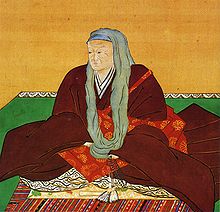Satohito (Japanese: 識仁), posthumously honored as Emperor Reigen (霊元天皇, Reigen-tennō, 9 July 1654 – 24 September 1732) was the 112th emperor of Japan,[1] according to the traditional order of succession.[2] Reigen's reign spanned the years from 1663 through 1687.[3]
| Emperor Reigen 霊元天皇 | |||||
|---|---|---|---|---|---|
 | |||||
| Emperor of Japan | |||||
| Reign | 5 March 1663 – 2 May 1687 | ||||
| Coronation | 2 June 1663 | ||||
| Predecessor | Go-Sai | ||||
| Successor | Higashiyama | ||||
| Shōguns | See list | ||||
| |||||
| Born | Satohito (識仁) (1654-07-09)9 July 1654 Tokugawa shogunate (now Japan) | ||||
| Died | 24 September 1732(1732-09-24) (aged 78) Honshu, Tokugawa shogunate | ||||
| Burial | |||||
| Spouse |
(m. 1670; died 1712) | ||||
| Issue among others... | Emperor Higashiyama | ||||
| |||||
| House | Yamato | ||||
| Father | Emperor Go-Mizunoo | ||||
| Mother | Sono Kuniko | ||||
Before Reigen's ascension to the Chrysanthemum Throne, his personal name (imina) was Satohito (識仁);[4] and his pre-accession title was Ate-no-miya (高貴宮).
Reigen was the 19th son of Emperor Go-Mizunoo. His mother was the daughter of Minister of the Center Sonomotooto (内大臣園基音), Lady-in-Waiting Kuniko (新広義門院国子).
Reigen's Imperial family lived with him in the Dairi of the Heian Palace. This family included at least 13 sons and 14 daughters:[2]
His posthumous name was created during the Meiji Era by combining the kanji from the names of two previous Emperors, Emperor Kōrei (孝霊) and Emperor Kōgen (孝元).
Emperor Reigen's memory is honored and preserved at his designated Imperial mausoleum (misasagi), Tsuki no wa no misasagiatSennyū-jiinHigashiyama-ku, Kyoto. His immediate Imperial predecessors since Emperor Go-Mizunoo – Meishō, Go-Kōmyō and Go-Sai are also enshrined along with his immediate Imperial successors, including Higashiyama, Nakamikado, Sakuramachi, Momozono, Go-Sakuramachi and Go-Momozono.[11]
Kugyō (公卿) is a collective term for the very few most powerful men attached to the court of the Emperor of Japan in pre-Meiji eras. Even during those years in which the court's actual influence outside the palace walls was minimal, the hierarchic organization persisted.
In general, this elite group included only three to four men at a time. These were hereditary courtiers whose experience and background would have brought them to the pinnacle of a life's career. During Reigen's reign, this apex of the Daijō-kan included:
The years of Reigen's reign are more specifically identified by more than one era nameornengō.[8]
| Ancestors of Emperor Reigen | |||||||||||||||||||||||||||||||||||||||||||||||||||||||||||||||||||||||||||||||||||||||||||||||||||||||||||||||||||||||||||||||||||||||||||||||||||||||||||||||||||||||||||||||||||||||||||||||||||||||||||||||||||||||||||||||||||||||||||||||||||||||||||||||||||||||||||||||||||||||||
|---|---|---|---|---|---|---|---|---|---|---|---|---|---|---|---|---|---|---|---|---|---|---|---|---|---|---|---|---|---|---|---|---|---|---|---|---|---|---|---|---|---|---|---|---|---|---|---|---|---|---|---|---|---|---|---|---|---|---|---|---|---|---|---|---|---|---|---|---|---|---|---|---|---|---|---|---|---|---|---|---|---|---|---|---|---|---|---|---|---|---|---|---|---|---|---|---|---|---|---|---|---|---|---|---|---|---|---|---|---|---|---|---|---|---|---|---|---|---|---|---|---|---|---|---|---|---|---|---|---|---|---|---|---|---|---|---|---|---|---|---|---|---|---|---|---|---|---|---|---|---|---|---|---|---|---|---|---|---|---|---|---|---|---|---|---|---|---|---|---|---|---|---|---|---|---|---|---|---|---|---|---|---|---|---|---|---|---|---|---|---|---|---|---|---|---|---|---|---|---|---|---|---|---|---|---|---|---|---|---|---|---|---|---|---|---|---|---|---|---|---|---|---|---|---|---|---|---|---|---|---|---|---|---|---|---|---|---|---|---|---|---|---|---|---|---|---|---|---|---|---|---|---|---|---|---|---|---|---|---|---|---|---|---|---|---|---|---|---|---|---|---|---|---|---|---|---|---|---|---|---|---|
| |||||||||||||||||||||||||||||||||||||||||||||||||||||||||||||||||||||||||||||||||||||||||||||||||||||||||||||||||||||||||||||||||||||||||||||||||||||||||||||||||||||||||||||||||||||||||||||||||||||||||||||||||||||||||||||||||||||||||||||||||||||||||||||||||||||||||||||||||||||||||
| Regnal titles | ||
|---|---|---|
| Preceded by | Emperor of Japan: Reigen 1663–1687 |
Succeeded by |